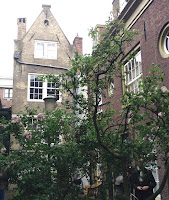We
had a great trip that was smooth and surprise free. Venice was our favourite,
the delightful
boutique hotel, Hotel Bella Venezia, was quite wonderful, its location was perfect and the rooms were very luxurious. Their breakfasts were amazing: coffee got sent from the bar rather than from the machine, just because the server took a liking to me. We loved the Venetian glass and brought home some beads as well as three whisper light Italian linen dresses! One cannot get a bad meal in Italy. In Florence the Uffizi got checked off our bucket list. Our last stop, Soriano, was a perfect rest, the scenery was stunning, especially from our window, of Castello Orsini. With no car, we walked everywhere and found it to be a very walkable town, even though there were times we were dodging the traffic of teeny cars and delivery trucks. The walk up and down the mountain kept the pounds off!
We learned from a guide at the Orsini Castle that the houses all jammed up against the castle were configured that way not just for protection of the plebeians (who wouldn't have far to escape to castle in case of attack), but so that said castle would be easier to defend, what with all those twisting alleys and pathways.
boutique hotel, Hotel Bella Venezia, was quite wonderful, its location was perfect and the rooms were very luxurious. Their breakfasts were amazing: coffee got sent from the bar rather than from the machine, just because the server took a liking to me. We loved the Venetian glass and brought home some beads as well as three whisper light Italian linen dresses! One cannot get a bad meal in Italy. In Florence the Uffizi got checked off our bucket list. Our last stop, Soriano, was a perfect rest, the scenery was stunning, especially from our window, of Castello Orsini. With no car, we walked everywhere and found it to be a very walkable town, even though there were times we were dodging the traffic of teeny cars and delivery trucks. The walk up and down the mountain kept the pounds off!
We learned from a guide at the Orsini Castle that the houses all jammed up against the castle were configured that way not just for protection of the plebeians (who wouldn't have far to escape to castle in case of attack), but so that said castle would be easier to defend, what with all those twisting alleys and pathways.






























